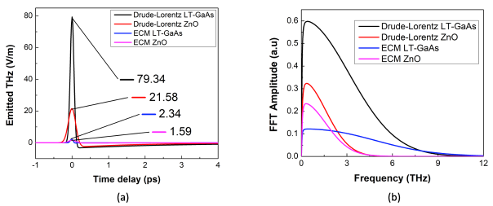VOLUME 18 NUMBER 1 (January to June 2025)

SciEnggJ. 2025 18 (1) 038-043
available online: March 31, 2025
DOI: https://doi.org/10.54645/2025181LIF-21
*Corresponding author
Email Address: jcarcilla@up.edu.ph
Date received: March 7, 2024
Date revised: July 19, 2024
Date accepted: July 19, 2024
ARTICLE
Terahertz emission from zinc oxide and low-temperature grown gallium arsenide photoconductive antennas: a comparative analysis using Drude-Lorentz and equivalent circuit models
The terahertz (THz) emission characteristics of zinc oxide (ZnO) and the widely used low-temperature-grown gallium arsenide (LT-GaAs) photoconductive antennas (PCA) were investigated and compared by employing the Drude-Lorentz model and the equivalent circuit model (ECM). The calculated peaks are 79.34 V/m, and 21.58 V/m for LT-GaAs, and ZnO, respectively using the Drude-Lorentz model. Meanwhile, via the ECM, the THz emission peak values are 2.34 V/m, and 1.59 V/m for LT-GaAs, and ZnO, respectively. Additionally, we also demonstrated the laser pump power (Ppump) dependence and bias voltage (Vbias) dependence of both substrates using the Drude-Lorentz model, and ECM, then subjected both substrates to their respective literature-reported breakdowns for breakdown voltage (VB) and optical damage threshold (PB). The maximum emission values until VB were calculated to be 307.34 V/m for LT-GaAs, and 1292.48 V/m for ZnO using the Drude-Lorentz model. Subsequently for ECM, the maximum emission values before VB were 14.05 V/m, and 95.11 V/m for LT-GaAs and ZnO respectively. Similarly, the maximum emitted THz values until PB for the Drude-Lorentz model were 317.34 V/m for LT-GaAs, and 323.66 V/m for ZnO. On the other hand, using ECM, the maximum emitted values before PB were 210.87 V/m, and 327.90 V/m for LT-GaAs, and ZnO, respectively. These findings offer valuable insights for choosing the optimal parameters in the design and operation of future ZnO and LT-GaAs-based PCA material.
© 2025 SciEnggJ
Philippine-American Academy of Science and Engineering